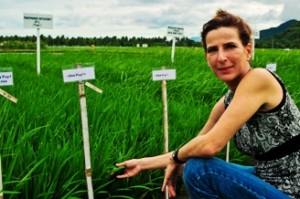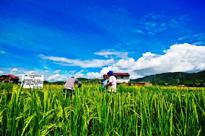 ALL IN THE ROOTS: A plant’s roots are a marvellously multitalented organ. They act as fingers and mouths helping plants forage and absorb water and nutrients. They act like arms and legs offering a sturdy base of support so a plant doesn’t keel over. They help store food and water, like our stomach and fat cells. And in some plants, can spawn new life – we leave that to your imagination!
ALL IN THE ROOTS: A plant’s roots are a marvellously multitalented organ. They act as fingers and mouths helping plants forage and absorb water and nutrients. They act like arms and legs offering a sturdy base of support so a plant doesn’t keel over. They help store food and water, like our stomach and fat cells. And in some plants, can spawn new life – we leave that to your imagination!
That is why it is of little surprise that this multitalented organ was the key to discovering why some rice lines yield better in phosphorus-poor soils, a puzzle whose answer has eluded farmers and researchers… until now. And even better, the findings hold promise for sorghum, maize and wheat too. Please read on!
In search of the key – The Gene Trackers
In 1999, Dr Matthias Wissuwa, now with the Japan International Research Centre for Agricultural Sciences (JIRCAS), deduced that Kasalath, a northern Indian rice variety, contained one or more genes that allowed it to grow successfully in low-phosphorus conditions.
For years, Matthias made it his mission to find these genes, only to find it was as easy as finding a needle in a genetic haystack. He teamed up with the International Rice Research Institute (IRRI), and with GCP’s support, the gene trackers were able to narrow the search down to five genes of interest.
“We had started with 68 genes and within three years, we had narrowed in on these five candidate genes. And then, one-by-one, we checked whether they were related to phosphorous uptake,” recollects Dr Sigrid Heuer, senior scientist at IRRI and leader of the team that published the discovery in Nature in August 2012.
“In the end we found that if a certain protein kinase gene was turned on in tolerant plants like Kasalath, then those plants would perform better in phosphorus-deficient soils.”
They named this protein kinase gene PSTOL1, which stands for Phosphorus Starvation Tolerance. “When we put this gene into intolerant rice varieties that did not have this gene, they performed better in phosphorus-deficient soils.”
The importance of phosphorus
Rice, like all plants, needs phosphorus to survive and thrive. It’s a key element in plant metabolism, root growth, maturity and yield. Plants deficient in phosphorus are often stunted.
Sigrid explains that whereas phosphorus is abundant in most soils, it is however not always easily accessible by plants. “Many soil types bond tightly to phosphorus, surrendering only a tiny amount to plant roots. This is why more than half of the world’s rice lands are phosphorus-deficient.”
Farmers can get around this by applying phosphate fertilisers. However this is a very expensive exercise and is not an option for the majority of the world’s rice growers, especially the poorer ones –the price of rock phosphate has more than doubled since 2007. The practice is also not sustainable since it is a finite resource.
By selecting for rice varieties with PSTOL1, growers will be less reliant on phosphate fertilisers.
How it works: unravelling PSTOL1 mechanics
In phosphorus-poor soils, PSTOL1 switches on during the early stage of root development. The gene tells the plant to grow larger longer roots, which are able to forage through more soil to absorb and store more nutrients.
“By having a larger root surface area, plants can explore a greater area in the soil and find more phosphorus than usual,” says Sigrid. “It’s like having a larger sponge to absorb more water.”
Although the researchers focussed on this one key nutrient, they found the extra root growth helped with other vital elements like nitrogen and potassium.
Another by-chance discovery was that phosphorus uptake 1 (Pup1), the collection of genes (locus) where PSTOL1 is found, is present within a large group of rice varieties.
“We found that in upland rice varieties – those bred for drought-prone environments – most have Pup1,” says Sigrid. “So the breeders in these regions have, without knowing it, been selecting for phosphorus tolerance.”
“When thinking about it, it makes sense as phosphorus is very immobile in dry soils, therefore these plants would have had to adapt to grow longer roots to reach water deeper in the soil and this, at the same time, helps to access more reservoirs of phosphorous .”
Breeding for phosphorus tolerance, and going beyond rice
Using conventional breeding methods, Sigrid says that her team introduced PSTOL1 into two irrigated rice varieties and three Indonesian upland varieties, and found that this increased yields by up to 20 percent.
“In our pot experiments,” she added, “when we use soil that is really low in phosphorus, we see yield increases of 60 percent and more. This will mean growers of upland rice varieties will probably benefit the most from these new lines, which is pleasing given they are among the poorest rice growers in the world.”
Read how Indonesian researchers are developing their own breeds of upland rice with the PSTOL1 gene
Sigrid also sheds light on broadening the research to other crop varieties: “The project team is currently looking at Pup1 in sorghum and maize and we are just about to start on wheat.”
Building capacity and ensuring impact
Like all GCP projects, this one invests as much time in building capacity for country breeding programmes as on research.
Sigrid and her team are currently conducting the first Pup1 workshop to train researchers from Bangladesh, India, Indonesia, Nepal, Philippines, Thailand and Vietnam. They will share molecular markers that indicate the presence of PSTOL1, techniques to select for the gene, as well as for new phosphorus-efficient varieties.
“The aim of these workshops is to take these important tools to where they are most needed and allow them to evolve according to the needs and requirements of each country,” says Dr Rajeev Varshney, GCP’s Comparative and Applied Genomics Leader. “Breeders will be able to breed new rice varieties faster and more easily, and with 100 percent certainty that their rice plants will have the gene. Within three to five years, each country will be able to breed varieties identical to those that growers know and trust except that they will now have the Pup1 gene and an improved ability to unlock and take up soil phosphorus.”
Joining hands in collaboration
This IRRI-led project was conducted in collaboration with JIRCAS and the Indonesian Center for Agricultural Biotechnology and Genetic Resources Research and Development (ICABIOGRAD) working with the Indonesian Centre for Rice Research. Other partners included: Italy’s University of Milano, Germany’s Max Planck Institute in Golm, the University of The Philippines at Los Baños, USA’s Cornell University and University of California (Davis and Riverside), Brazil’s EMBRAPA, Africa Rice Center, Iran’s Agricultural Biotechnology Research Institute, Australia’s Commonwealth Scientific and Industrial Research Organisation (CSIRO) and University of Dhaka in Bangladesh.
Links
- VIDEO: Watch Sigrid talk about the project on BBC World News in this short clip
- Press release: Rooting and shooting for rice
- Media coverage
- Improving rice in Asia
- Comparative Genomics Research Initiative
- Meet the PSTOL1 research team on Flickr or Facebook
- Sigrid’s profile
- Facts and figures on rice (IBP website)
- Join the rice research community online (IBP website)
Sigrid’s presentation at the GCP General Research Meeting 2011











You might be interested in the discussion on this paper here: http://agro.biodiver.se/2012/08/wild-about-rice-landraces/#comment-1097836
Thanks Luigi. We’ll follow the discussions.
We’ve followed the discussions. To our readers, please see IRRI statement on Kasalath origins here: http://bit.ly/QFrEOq and then scroll further down for subsequent comments posted.
Thanks again, Luigi and IRRI colleagues, for keeping us in the loop.